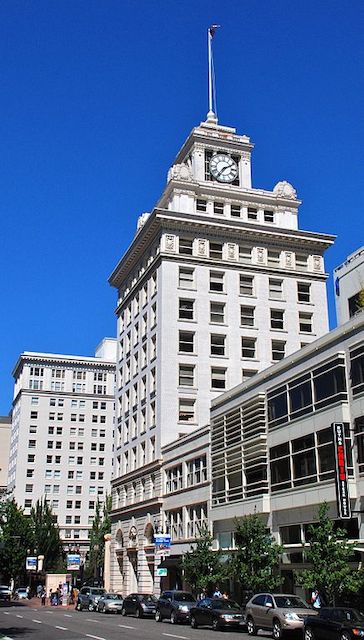Transit advocates cheered when, in 2018, a census of downtown Portland found that 42 percent of the 102,000 people who worked downtown took transit to work. What they didn’t want to hear is that less than 10 percent of workers in the Portland area worked downtown, and transit only carried 3.4 percent of non-downtown employees to work. As demographer Wendell Cox says, “transit is about downtown.”
 Long an icon of downtown Portland, Jackson Tower is facing hard times. Photo by Steve Morgan.
Long an icon of downtown Portland, Jackson Tower is facing hard times. Photo by Steve Morgan.
While I’ve reported on the impacts of telecommuting on transit, just as important is the decline of many downtowns due to the pandemic and the inability of many cities to solve problems of crime and homelessness. Portland’s downtown is doing so bad that the owners of Jackson Tower recently defaulted on their mortgage, which a representative of the owners blames on “the deterioration of downtown.” A court has appointed a receiver who may end up selling the graffiti-marked building at foreclosure.
Most downtowns aren’t as bad as Portland’s, but in general downtown office vacancy rates are nearly 19 percent, the highest in three decades. Even class A (premium) downtown offices are declining, whereas offices outside of downtowns are doing well, probably because many companies have moved their offices from downtowns to more suburban locations.
The migration of jobs out of downtowns joins telecommuting as major existential threats to urban transit. The problem is that transit agencies get so much of their money from taxpayers that they have had no incentive to redesign their transit systems for modern cities. Instead, many bus routes today still follow streetcar lines from a hundred years ago. Rather than fix this, most big-city agencies focused on building expensive rail lines into downtowns that were declining in importance long before the pandemics. Downtown property owners lobbied hard for these policies, but the result was that transit service to anyone going anywhere but to or from downtowns was lousy.
Even now, transit agencies are demanding rescues from the fiscal cliffs they face due to declining ridership. Hardly anyone is talking about reforming transit so it will better serve 21st century cities. Sadly, politicians will probably continue to reward transit for not carrying many passengers, thus taking away any incentive for transit agencies to modernize their systems.








The only people bidding at the foreclosure for that property will be people with government funded money. To “preserve downtowns” of for subsidized rentals.
Which means more tax dollars used to subsidize a failed business model caused by the same government leaders and bureaucrats who caused the problem in the first place,
At those ruinous occupancy rates, the reduced revenue cannot pay for taxes, mortgage-financing, and maintenance. The city has also seen scores of hotels go out of business as tourist industry revenue dropped.
Tourism once lifeblood many European cities…. is not replicate-able model. We have no castles or 500 year old monasteries.
Without thinking much about it, most people prefer traditional architecture. Now it seems as if more detailed and ornamental styles of design for buildings and cities are not only more popular but more natural and more healthy. These designs evoke buidings, never more than a few stories. Moderate density capacities where walkability, bike, transit, micro transit friendliness, doesn’t imply “CRAMMED” or stuffed or “Density”. This is not smart growth but marketable…. new urbanism. Density is a loveable, laughable pet subject…..
Small Buildings are Highly Adaptable….Small buildings are more adaptable for reuse as requirements change over time. Flexible building stock is essential for encouraging small businesses, local start-ups. Big buildings have almost no adaptive re-use…once built is destined to a 30-40 year shelf life…..
Check out a recent Apollo Group report. They shared cell phone activity for downtowns. A decent proxy for how much people are downtown, for work or pleasure. A lot of downtowns are still down 50%, some even more.
There are some downtowns like Salt Lake City that have more activity than before covid.
Kx1781, should you provide a link to the Apollo report?
*could not should